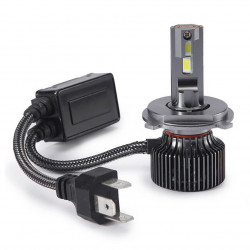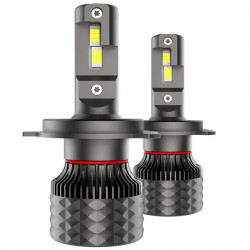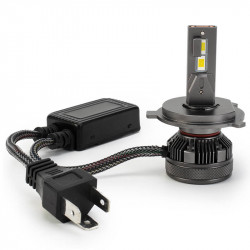Are 9003 and H4 bulbs the same headlight bulb type?
Introduction
Understanding the different types of headlight bulbs can be quite confusing, especially when you encounter terms like 9003, H4, and HB2. Are these bulbs the same? Can they be used interchangeably? This article dives into the details of 9003 and H4 bulbs, exploring their history, design, and regulations to clarify any confusion.
What Are 9003 and H4 Bulbs?
9003 and H4 bulbs are dual-filament headlight bulbs commonly used in vehicles for both low and high beams. While they might be referred to by different names in various regions, they essentially serve the same purpose and have similar specifications. The primary distinction lies in their nomenclature and regulatory compliance.
History of H4 Bulbs
H4 bulbs were first introduced in Europe in 1971, revolutionizing automotive lighting with their dual-filament design. This innovation allowed a single bulb to produce both low and high beams, enhancing convenience and efficiency. The H4 bulb quickly became popular worldwide, except in the United States, due to specific regulatory requirements.
Regulatory Differences
In the United States, automotive headlight regulations historically mandated the use of sealed beam headlights. This regulation prevented the widespread adoption of H4 bulbs, which are not sealed. Instead, the 9003 (also known as HB2) variant was developed to meet US standards. The primary difference between H4 and 9003 bulbs lies in their compliance with regional regulations rather than their design or function.
Design and Specifications
Both H4 and 9003 bulbs share similar physical and electrical characteristics. They feature a dual-filament design, allowing them to function as both low and high beams within a single bulb unit. Typically, these bulbs have a 55-watt low beam filament and a 60-watt high beam filament. The connectors are identical, with an exposed three-prong design, ensuring compatibility across various vehicle models.
Interchangeability
Despite the different names, H4 and 9003 bulbs are interchangeable in most applications. However, it’s crucial to adhere to local regulations when replacing headlight bulbs. In regions where specific regulations apply, such as the US, using a 9003 bulb instead of an H4 bulb ensures compliance with legal standards while maintaining the desired performance.
LED and HID Versions
With advancements in lighting technology, H4 and 9003 bulbs are now available in LED and HID versions. These modern alternatives offer several advantages, including increased brightness, longer lifespan, and improved energy efficiency. However, it’s essential to ensure that the beam pattern remains balanced and does not cause glare for oncoming drivers.
Applications in Vehicles
9003 and H4 bulbs are widely used in various vehicles, including motorcycles, snowmobiles, and many modern cars. Their dual-filament design makes them versatile and efficient, providing both low and high beams from a single bulb. This design is particularly beneficial for motorcycles, where space and weight considerations are critical.
Technical Standards and Beam Patterns
Headlight bulbs must adhere to specific engineering standards to ensure compatibility and performance. The beam pattern, in particular, is crucial for providing adequate road illumination without blinding oncoming drivers. Proper placement of the filament within the bulb is essential to achieve the desired beam pattern, which is why regulatory compliance is so important.
Performance Comparison
When comparing H4 and 9003 bulbs, factors such as brightness and lifespan come into play. LED versions of these bulbs typically offer superior brightness and longevity compared to their halogen counterparts. This enhancement significantly improves night driving visibility and overall safety on the road.
Choosing the Right Bulb
Selecting the appropriate H4 or 9003 bulb involves considering several factors, including brightness, beam pattern, and legal compliance. It’s advisable to opt for bulbs from reputable manufacturers that meet regulatory standards. Additionally, seeking bulbs with a balanced beam pattern ensures even road illumination and minimizes glare.
Installation and Replacement
Upgrading from halogen to LED or HID bulbs is a popular choice among vehicle owners. The installation process for 9003 (H4) bulbs is straightforward, but it’s crucial to follow safety precautions. Ensuring the new bulb is correctly aligned and securely installed helps maintain the proper beam pattern and prevents potential issues.
Common Misconceptions
There are several misconceptions surrounding 9003 and H4 bulbs. One common myth is that they are entirely different and cannot be used interchangeably. However, as we’ve discussed, these bulbs are essentially the same, with variations primarily due to regional regulatory requirements. Understanding this can help vehicle owners make informed decisions when replacing their headlight bulbs.
Conclusion
In summary, 9003 and H4 bulbs are essentially the same in terms of design and function, despite being known by different names in various regions. Their dual-filament design offers versatility and efficiency, making them a popular choice for both low and high beams in many vehicles. When selecting or upgrading these bulbs, it’s essential to consider factors like brightness, beam pattern, and regulatory compliance to ensure optimal performance and safety on the road.
FAQs
1. What is the difference between H4 and 9003 bulbs? H4 and 9003 bulbs are essentially the same in design and function. The primary difference lies in their compliance with regional regulations, with 9003 being the US-compliant variant.
2. Can I replace my halogen bulb with an LED? Yes, you can replace a halogen bulb with an LED version. LED bulbs offer better brightness and longevity, but ensure they have a balanced beam pattern to avoid glare.
3. Why were H4 bulbs not initially used in the US? H4 bulbs were not initially used in the US due to regulations requiring sealed beam headlights. The 9003 variant was developed to meet US standards while retaining the dual-filament design.
4. How do I ensure my headlights are legally compliant? To ensure legal compliance, use bulbs that meet local regulatory standards. In the US, look for 9003 bulbs with DOT certification for compliance with federal regulations.
5. What are the benefits of upgrading to LED headlights? Upgrading to LED headlights offers benefits such as increased brightness, longer lifespan, and improved energy efficiency. LEDs also provide better night driving visibility, enhancing overall road safety.









